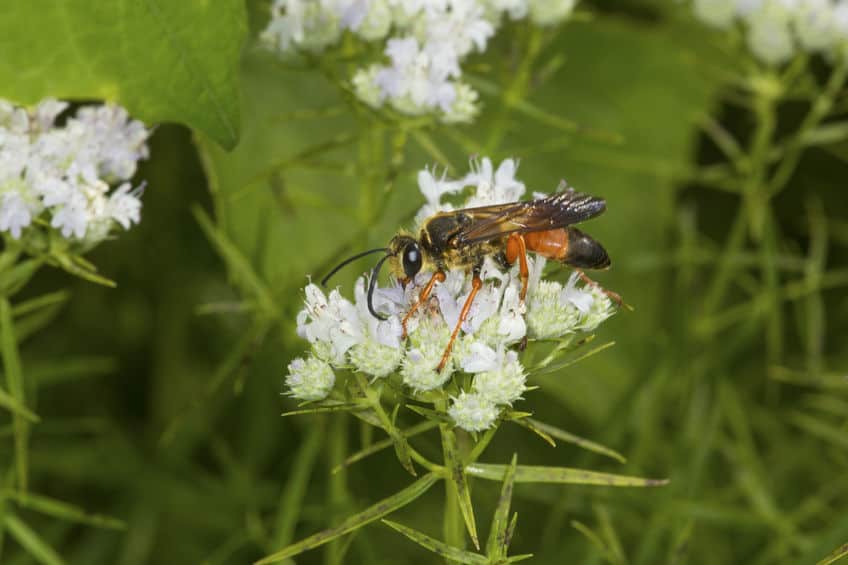The great golden digger wasp, Sphex ichneumoneus, also known as the great golden sand digger, is found in the Americas. They are about 0.8 inches (2 cm) long.
How did the great golden digger wasp get its name?
They are named after their golden hair. The great golden digger wasp has small tufts of golden hair on its head and on its thorax. Its orange colored legs and abdomen also make it a very striking wasp and easy to identify. They are also a type of digger wasp.

What do golden digger wasps prey on?
They paralyze crickets and grasshoppers for their young to consume alive. Like almost all solitary wasps they are parasitoids. They prey on crickets to feed to their larvae but do not kill the crickets outright. Rather they paralyze it so that the meat remains fresh for as long as possible. The crickets are taken to the burrow whereby the digger wasp lays her eggs on the cricket. Once hatched the larva feeds on the cricket which can stay alive for several days.
What do golden digger wasps eat?
The golden digger wasp larvae eat crickets and grasshoppers but the adult wasps primarily eat nectar. The adults are fuelled on carbohydrates rather than meat. All the hunting they do is to cater to their offspring rather than their own needs. Read more here.
Do great golden digger wasps make nests?
They dig in the earth to make nests. They are called digger wasps due to their nests which they dig in the ground. They can make up to six nests in a season and prepare different sections in each nest. They will lay a single egg in each section, after stuffing it with paralyzed crickets, before sealing it.
Do great golden digger wasps have any distinct behaviors?
They always check their nests before depositing a cricket. The golden digger wasp has been found to follow a very distinct pattern of behavior when taking a cricket back to her burrow. She will leave the paralyzed cricket at the entrance of the burrow before going in to check the burrow is clear. Only then does she drag the cricket in by its antennae.
Why are great golden digger wasps studied so much?
Their behavior might be genetically automated. Studies of these wasps have proved fascinating for the discussion of free will and are widely discussed in cognitive science. The wasp’s behavior at first appearance seems very complex and suggests intelligence, but experiments seemed to show that the wasp is only following a predetermined pattern of behavior and can not successfully adapt when the pattern is disrupted. Researchers found that by slightly moving a captured cricket from the position left by the wasp it became confused and its behavior pattern was in effect reset making it repeat its actions time and time again. This is used as evidence that wasps do not actually have free will.
However, Fred Keijzer points out that while this study has been widely reported there is also evidence that it might not actually be fully true. He points to the fact that although the wasp could be fooled up to twenty times it did eventually adapt its behavior thereafter. (source)
Do golden digger wasps sting?
They can sting. They are solitary and like many such solitary wasps, such as the great black wasp, have not adapted painful stings. Their sting is used to paralyze its prey to feed its young. The sting of this wasp is not very painful to people and it will not sting unless under severe duress.
Do golden digger wasps pollinate?
They are good pollinators and harmless to people. Like almost all wasps they play an important role as pollinators as they primarily feed on nectar.
